Good morning,
I have this problem / question:
He is renovating the house and I would like to ask about the lightning protection and earthing systems.
In the photo below, I hope I have illustrated everything.
An electrician made two groundings by hammering pins and connected them with a hoop. From one pin (cross joint - I think it is called) he led out the hoop to ground the cable joint (apparently it is necessary - energy requirements) - in this ZK box the PEN is divided and a new power cable for mixing (five-core) is introduced
From the other pin from the cross connector, he introduced a hoop tie into the basement and connected it to such a rail (GSW / GSU?)
Then the electrician wanted to connect these two more pins to the lightning protection system.
I have a doubt here whether this is correct - will the electrician make a mistake connecting the building ground to the lightning ground?
My understanding is that in the event of a storm (lightning strike) - through the lightning protection system, a dangerous load may be transferred to a part of the home installation.
On the other hand, I think that the connection of the earth electrode with the grenadier may not be a mistake, because it is the same potential and I think that's what it is all about.
I am asking for your opinion and possible explanation before something is wrongly done.
I have this problem / question:
He is renovating the house and I would like to ask about the lightning protection and earthing systems.
In the photo below, I hope I have illustrated everything.
An electrician made two groundings by hammering pins and connected them with a hoop. From one pin (cross joint - I think it is called) he led out the hoop to ground the cable joint (apparently it is necessary - energy requirements) - in this ZK box the PEN is divided and a new power cable for mixing (five-core) is introduced
From the other pin from the cross connector, he introduced a hoop tie into the basement and connected it to such a rail (GSW / GSU?)
Then the electrician wanted to connect these two more pins to the lightning protection system.
I have a doubt here whether this is correct - will the electrician make a mistake connecting the building ground to the lightning ground?
My understanding is that in the event of a storm (lightning strike) - through the lightning protection system, a dangerous load may be transferred to a part of the home installation.
On the other hand, I think that the connection of the earth electrode with the grenadier may not be a mistake, because it is the same potential and I think that's what it is all about.
I am asking for your opinion and possible explanation before something is wrongly done.



